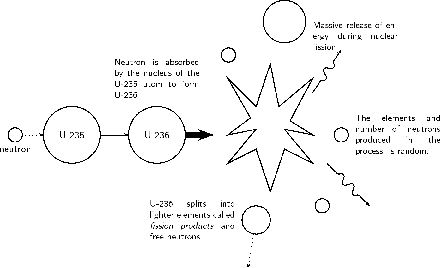| << Chapter < Page | Chapter >> Page > |
Nuclear fission is a process where the nucleus of an atom is split into two or more smaller nuclei, known as fission products . The fission of heavy elements is an exothermic reaction and huge amounts of energy are released in the process. This energy can be used to produce nuclear power or to make nuclear weapons , both of which we will discuss a little later.
The splitting of an atomic nucleus into smaller nuclei
Below is a diagram showing the nuclear fission of Uranium-235. An atom of Uranium-235 is bombarded with a neutron to initiate the fission process. This neutron is absorbed by Uranium-235, to become Uranium-236. Uranium-236 is highly unstable and breaks down into a number of lighter elements, releasing energy in the process. Free neutrons are also produced during this process, and these are then available to bombard other fissionable elements. This process is known as a fission chain reaction , and occurs when one nuclear reaction starts off another, which then also starts off another one so that there is a rapid increase in the number of nuclear reactions that are taking place.

A nuclear chain reaction can happen very quickly, releasing vast amounts of energy in the process. In 1939, it was discovered that Uranium could undergo nuclear fission. In fact, it was uranium that was used in the first atomic bomb. The bomb contained large amounts of Uranium-235, enough to start a runaway nuclear fission chain reaction. Because the process was uncontrolled, the energy from the fission reactions was released in a matter of seconds , resulting in the massive explosion of that first bomb. Since then, more atomic bombs have been detonated, causing massive destruction and loss of life.
Read the article below which has been adapted from one that appeared in 'The Globe' in Washington on 10th October 2006, and then answer the questions that follow.
US officials and arms control specialists warned yesterday that North Korea's test of a small nuclear device could start an arms race in the region and threaten the landmark global treaty designed nearly four decades ago to halt the spread of nuclear weapons. US officials expressed concern that North Korea's neighbors, including Japan, Taiwan, and South Korea, could eventually decide to develop weapons of their own. They also fear that North Korea's moves could embolden Iran, and that this in turn could encourage Saudi Arabia or other neighbours in the volatile Middle East to one day seek nuclear deterrents, analysts say.
North Korea is the first country to conduct a nuclear test after pulling out of the Nuclear Nonproliferation Treaty. The treaty, which was created in 1968, now includes 185 nations (nearly every country in the world). Under the treaty, the five declared nuclear powers at the time (United States, the Soviet Union, France, China, and Great Britain) agreed to reduce their supplies of nuclear weapons. The treaty has also helped to limit the number of new nuclear weapons nations.

Notification Switch
Would you like to follow the 'Siyavula textbooks: grade 11 physical science' conversation and receive update notifications?